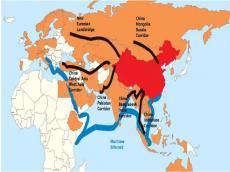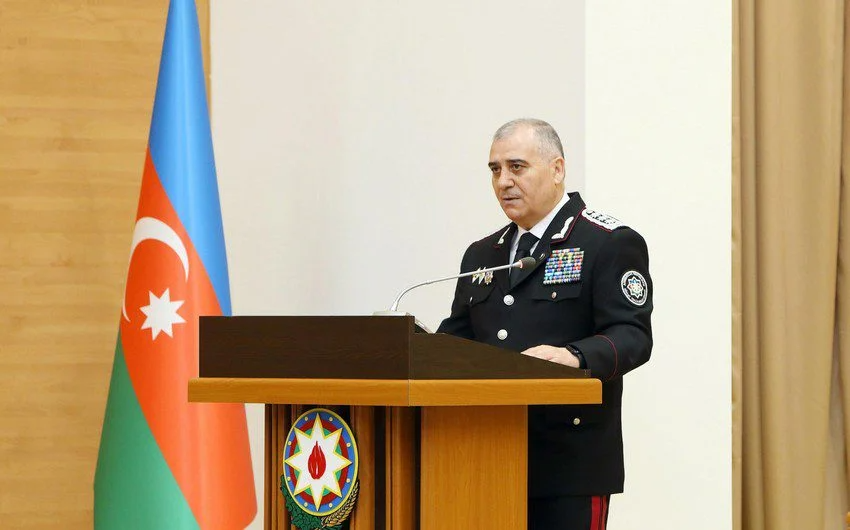|
|
TODAY.AZ / Politics
BRI & role of Middle Corridors & forces of hegemony
03 March 2023 [10:44] - TODAY.AZ

The Chinese One Belt & One Road Initiative (BRI) has entered its 10th year during which it has succeeded in winning the “hearts and minds” of the people living around the globe. However, forces of hegemony are also active to derail the project in Central Asia through false and fake propaganda.
Actually, they tried to start another “end-game” to sabotage the socioeconomic and geopolitical development in these countries. Even before the scheduled visit of US Secretary of State Antony Blinken to India, Kazakhstan, and Uzbekistan, US Assistant Secretary for South and Central Asian Affairs Donald Lu showed his country’s serious concerns about the Chinese loans and projects.
On the contrary, the BRI has been a “connecting hub” and “bridging force” between the continents, communities, and corporations, working jointly to achieve the dreams of greater regional connectivity through world-class infrastructure development, immense socio-economic integration, and last but not the least formation of middle corridors. In this regard, the formation of the Middle Corridor (MC) has further enhanced the BRI connectivity and potential utility.
The MC is a trade route that spans the Central Asian green fields, the Caspian Sea, and the Caucasus Mountains, and the dawn of the BRI has further enhanced its trans-regional connectivity. The route is part of China’s ‘Belt and Road’ initiative. It is known as the China-Central Asia-West Asia Corridor which links China and the regional markets of East Asia with Georgia, Turkey, and the European markets.
The Russia-Ukraine conflict has opened a new window of opportunity for the regional countries. Leaders of Azerbaijan, Georgia, and Central Asian States have grasped the emerging opportunity and initiated inter-state cooperation through regular bilateral visits and the signing of memorandums on the minimization of tariffs and border crossing hurdles and jointly working for the development of the MC. In this regard, Turkey first conceived the corridor in the late 2000s, creating the necessary ferry, port, railway, and road infrastructure across Central Asia and the Caspian Sea.
There have been lots of meaningful projects launched for the further strengthening of the MC. The Trans-Kazakhstan Railway was opened in 2014. The completion of the Baku-Tbilisi-Kars Railway was another milestone completed in 2017. It enabled rail passage through the Caucasus Mountains for the first time since the 1990s.
Seemingly, Azerbaijan, Georgia, Kazakhstan, and Uzbekistan in particular, actively collaborated to turn the MC into a reality. Together with China and Turkey, these countries have held a series of conferences and ministerial meetings to improve their cross-border rail links and reduce trade friction between them.
Azerbaijan holds the geographical advantage in the MC and is situated on the East-West trade route, connecting Europe and China, opening up a lot of opportunities. It has enhanced its potential for transit shipments, transport, and logistics sectors.
In November 2022, Kazakhstan, Azerbaijan, Georgia, and Turkey signed a roadmap for the simultaneous elimination of bottlenecks and the development of the Middle Corridor for 2022-2027. The implementation of the agreements will allow increasing the capacity along the corridor to 10 million tons per year by 2025
At the same time, the MC promises to become a regional power center. Even Uzbekistan has supported the development of the MC and tries to build its own railway networks that would connect to the corridor. According to Uzbekistan Railways (December 2022), Uzbekistan organized a train bypassing Russia in December 2022.
For the further strengthening of the MC Azerbaijan, Türkiye, and Uzbekistan signed the Tashkent Declaration to reshape the cooperation of the participating countries in multiple spheres from economy to trade, transportation, and energy, as well as address the regional and global security challenges.
To conclude, CPEC Phase II has the potential to further enhance the prospects of greater regional connectivity between the South Asia, Central Asia, and South Caucasus regions. In this regard, there is an urgent need to further improve regional trade with all the Central Asian countries and Azerbaijan. Pakistan, Azerbaijan, Kazakhstan, and Uzbekistan's trade and economic relations are constantly on the rise which should be further expanded because the potential of trade between both regions is much greater than the current level of trade volumes.
Azerbaijan’s “superior” and “supporting” economic policies, befitting a “trade model” with lots of “custom exemptions”, direct flight connectivity, and strategic partnership has become a role model for other regional countries for achieving desired goals of greater regional connectivity.
Kazakhstan’s rigorous and diversified “in-person approach” has given it a comparative advantage in this regard. It follows holistic and comprehensive innovative diplomacy to increase bilateral relations in the diverse sectors of the economy i.e. pharmaceutical, civil aviation (April 2023 direct flights), SMEs, energy, real estate, oil & gas, agriculture, and last but not the least joint ventures in sports, surgical instruments and textiles with Pakistan and its private companies.
Uzbekistan’s “systematic” and “supportive” policies of greater regional connectivity have surpassed all the regional countries. The trans-regional railway project (Pakistan-Uzbekistan-Afghanistan)” would be a “game changer” in the context of greater regional connectivity and trade in the days to come. Pakistan-Uzbekistan bilateral trade, economic, business, and trade activities have been further increased because of its pure but simple economic diplomacy.
There is an immense potential for enhancing trade in the field of agriculture and agro-products, which needed to be tapped. Maximum facilitation should be provided to the investors of all Azerbaijan, Kazakhstan, and Uzbekistan to help set up their businesses in the already established Special Economic Zones across Pakistan.
There is huge scope for higher education cooperation through joint degrees and student and faculty exchange programs. The Virtual University of Pakistan is offering online education, which is cost-effective for students of these countries.
Most recently, the 8th Session of the Pakistan-Uzbekistan Inter-governmental Commission (IGC) on Trade-Economic and Scientific-Technical Cooperation was held in Uzbekistan. It was mutually agreed to extend cooperation in priority areas like transport and logistics. Moreover, the growth of mutual trade, investment, industrial cooperation, and banking was also discussed. It was decided to further increase bilateral trade which reached $240 million in 2022 (the highest among CIS). Both countries mutually supported the adoption of concrete measures to accelerate the practical implementation of the Agreement on Preferential Trade and Diversification of Transport Corridors in order to create prerequisites for increasing the volume of mutual trade.
An agreement was also inked to accelerate the progress of the trans-Afghan railway construction project. Moreover, MOUs to increase the volume of multimodal cargo transportation, and the creation of terminals on the territories of both states for further joint export of products to the markets of third countries were also signed. Furthermore, the interbank partnership was also discussed to implement the mechanism of SWAP operations between central banks, and the development of correspondent banking relations between the financial institutions of the two countries. The closure of banking connections should be halted and immediately restored.
URL: http://www.today.az/news/politics/232299.html
 Print version
Print version
Connect with us. Get latest news and updates.
See Also
- 01 May 2025 [15:23]
Baku court reviews video alleging criminal Ishkhanyan blocked Azerbaijani troops from reaching Shusha - 01 May 2025 [15:17]
Azerbaijani youth representative highlights green innovation and leadership at UN ECOSOC Youth Forum - 01 May 2025 [14:35]
Video shown in Baku court confirms Arkady Ghukasyan’s presence in Shusha after occupation - 01 May 2025 [13:31]
Special forces of Azerbaijan - legendary warriors of the 44-day war - 01 May 2025 [13:24]
Azerbaijani Air Force personnel receive NATO training on air operations planning - 01 May 2025 [12:21]
What Remains Misunderstood After 30 Years of Occupation? - 01 May 2025 [12:04]
Kamran Aliyev reappointed as Prosecutor General of Azerbaijan - 01 May 2025 [11:43]
Israel seeks help from Azerbaijan and others to battle massive forest fires - 30 April 2025 [14:25]
President Ilham Aliyev inaugurates several facilities in Sumgayit Chemical Industrial Park - 30 April 2025 [12:24]
President Aliyev: Azerbaijan attaches special importance to enhancement of relations with Israel
Most Popular
 Paraguay designates Hamas, Hezbollah, Iranian Guards as terrorist organizations
Paraguay designates Hamas, Hezbollah, Iranian Guards as terrorist organizations
 United States announce plans to offer Japan to build dual-use ships
United States announce plans to offer Japan to build dual-use ships
 China accuse US of supporting Taiwan's ambitions
China accuse US of supporting Taiwan's ambitions
 National Bank of Kyrgyzstan issue silver coin in honor of 80th anniversary of Victory over Fascism
National Bank of Kyrgyzstan issue silver coin in honor of 80th anniversary of Victory over Fascism
 Azerbaijan, Saudi Arabia eye expansion of air connectivity
Azerbaijan, Saudi Arabia eye expansion of air connectivity
 Ali Nagiyev: Azerbaijan has always supported international efforts to ensure Afghanistan’s stability and security
Ali Nagiyev: Azerbaijan has always supported international efforts to ensure Afghanistan’s stability and security
 China intends to make electric vehicles leaders in car sales by 2035
China intends to make electric vehicles leaders in car sales by 2035
